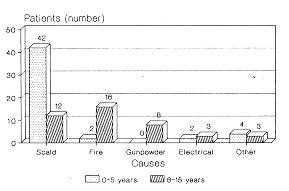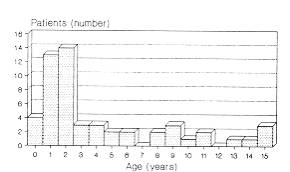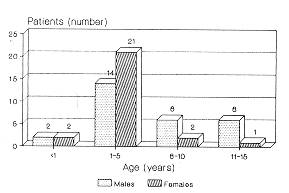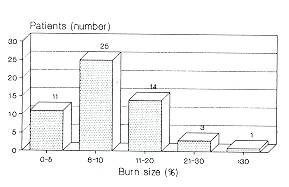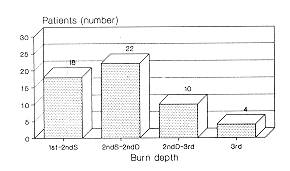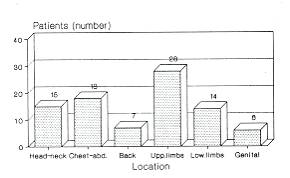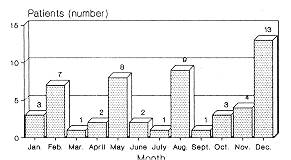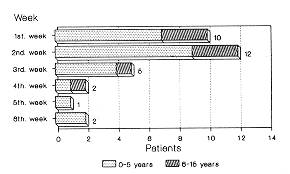| Ann. Medit. Burns Club - vol. 6 - n. 3 - September 1993
EPIDEMIOLOGICAL STUDY OF SCALDING IN CHILDREN Reig A., Tejerina C., Baena R, Mirabet V. Department of Plastic Surgery and Burn Centre, Hospital la Fe, Valencia, Spain SUMMARY. A retrospective epidemiological study is made of scald bums in patients under age 16 admitted to our Bum Centre during 1988 and 1989. A total of 3711 patients were treated, of whom 302 (8.1%) were hospitalized. Of the latter, 92 (30.4%) were under age 16. In these cases scalding was the cause of lesion in 54 patients (58.7%), corresponding to 26 girls and 28 boys (mean age, 3.6 years); 72.2% were under 6 years of age. The mean burn extent was 13.2% BSA, and the most commonly affected region was the upper limbs (51.8%). Over 90% of the accidents occurred at home. Surgery was performed at least once in 59% of cases. The mean hospital stay was 14.9 days. Introduction Burns are still frequent, and the
resulting lesions often lead to physical and psychological problems for the patients. Patients and Methods Ninety-two case histories were
reviewed, corresponding to patients aged 0- 15 years admitted to our Bum entre between 1
January 1988 and 31 December 1989, with the aim of establishing the incidence and cause of
scalding among paediatric patients.
Results Age The mean patient age was 3.6% years. Fig. 2 shows patient distribution by age. Most accidents were found to affect children under 6 years of age (72.2%), 50% being aged 1-2 years.
Sex Of the 54 children with scald bums, 26 were girls (48.1%) and 28 boys (51.8%), Girls were more commonly affected among those under 5 years of age, whereas males predominated over age 5. Fig. 3 shows patient distribution by age and sex.
Burn extent Scald burns were found to affect an average of 13.2% TBSA (range, 2-35%). Most patients (66.6%) suffered burns that affected less than 10% TBSA, and only one patient suffered burns of over 30% TBSA (Fig. 4). Fig. 5 shows the relationship between burn extent and patient age; the most extensive burns generally affected older children.
Burn depth Fig. 6 shows patient distribution according to bum depth. Of the 54 patients considered, 18 (33%) suffered first- and second-degree superficial wounds; 22 (40.7%) presented second-degree superficial burns together with second-degree deep lesions. Ten patients (18.5%) suffered second-degree deep burns associated with third-degree lesions. Four patients (7.4%) presented isolated third-degree burns. The relationship between burn depth and wound extension is shown in Table 1.
Burn location Fig. 7 shows patient distribution according to burn
location. The upper limbs were the most commonly affected body region (51.8%), both
isolatedly and in association with other locations. The second most commonly affected area
was the head and neck, these lesions mainly being associated with burns of the upper
thorax.
Aetiology Over 90% of the burns occurred at home, and particularly in the kitchen. Scalding was often caused by hot liquids in cups and dishes (37. 1 %), pots (27.7%) and tea- or coffee-pots (25.9%). Bath water was responsible for 9.3% of scald bums. Season Bum distribution according to the month of
the year is shown in Fig. 8. The accidents were found to be most common m December (24%),
followed by August (16.6%) and May (14.8%).
Surgical treatinent Fig. 9 shows the number of patients operated on following hospital admission; 59.2% of patients received at least one skin graft operation. In two-thirds of cases surgery was performed during the first two weeks following hospitalization. In the patients aged 0-5 years, successive interventions were required in 12% of cases, versus 25% in those aged 6-15 years. This reflects the greater relative severity of the bums in the older children.
Hospital stay The mean hospital stay was 14.9 days. In patients aged 0-5 years, the average was 12.3 days, versus 19.7 days for those aged 6-15. This difference also reflects the greater relative severity of the bums in the older children. Comment Bums continue to pose problems in
modem society, with frequent physical and psychological consequences among the patients
affected. A number of studies have shown that bums more often affect younger individuals,
particularly those in the 0-5 years age range (Smith and O'Neill, 1984). These children
are characteristically at risk of suffering scald bums.
RESUME. Cette étude rétrospective des brûlures par ébouillanternent subies par les patients âgés de moins de 16 ans visités dans notre Centre des Brûlés dans la période 1988-89 démontre que sur les 3711 patients de tous les âges traités 302 (8,1%) ont été hospitalisés, dont 92 (30,4%) âgés de moins de 16 ans. Dans ces derniers cas l'ébouillantement représentait la cause de la lésion chez 54 patients (58,7%), dont 26 de sexe féminin et 28 masculin (âge moyen 3,6 ans); les enfants âgés de moins de 6 ans constituaient 72,2% de la totalité. L'extension moyenne des brûlures était 13,2%, et les membres supérieurs étaient la partie du corps la plus fréquemment atteinte (51,8%). Plus de 90% des accidents se sont produits dans la maison. Les jeunes patients ont subi une opération chirurgicale dans 59% des cas et la durée moyenne de l'hospitalisation était 14,9 jours. BIBLIOGRAPHY
|
||||||||||||||||||||||||||||||||||||||||||||||||||||||||||||||||||||||||||||||
